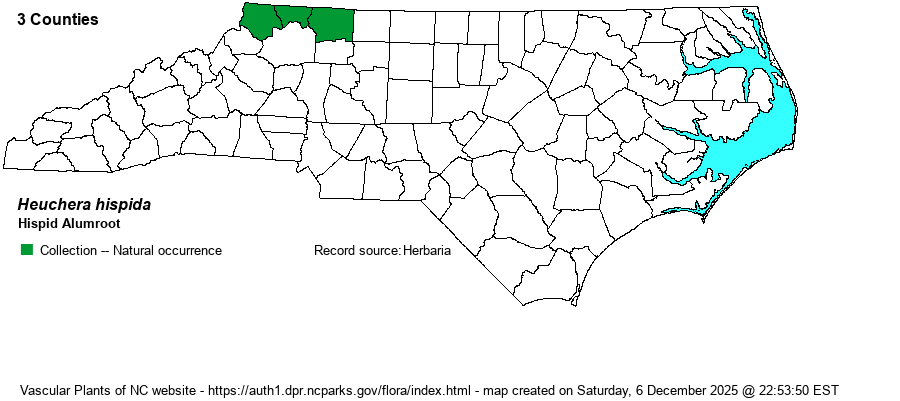| Section 6 » Family Saxifragaceae |
Show/Hide Synonym
| taxonName | relationship | relatedTaxonName | relatedTaxonRefText | relComments |
|---|
|
|
|
|
|
|
| Heuchera hispida | = | Heuchera ×hispida | Gleason and Cronquist (1991) | | | Heuchera hispida | = | Heuchera americana var. hispida | Flora of North America (1993b, 1997, 2000, 2002a, 2002b, 2003a, 2004b, 2005, 2006a, 2006b, 2006c, 2007a, 2009, 2010) | | | Heuchera hispida | = | Heuchera americana var. hispida | | | | Heuchera hispida | = | Heuchera americana var. hispida | | | | Heuchera hispida | = | Heuchera americana var. hispida | Soltis in Kubitzki, Bayer, & Stevens (2007). The keys partly adapted from Wells (1984). | | | Heuchera hispida | < | Heuchera americana | Radford, Ahles, and Bell (1968) | | | Heuchera hispida | < | Heuchera americana | Wofford (1989) | | | Source: Weakley's Flora |
|
| Author | Pursh | |
| Distribution | Restricted to the northern Mountains and extreme northwestern Piedmont -- specimens from Ashe, Alleghany, and Surry counties. These specimens are in the NCU herbarium, which the website editors feel have been confidently vetted for accuracy. A specimen from Haywood County, much farther to the southwest, is in another herbarium, but the editors choose to follow Weakley (2024) and the NCU specimen data for its range map. Photos of one or two individuals, with the inflorescence, are posted on Facebook Weakley's Flora of the Southeastern United States; photos are from late April 2025 by Ryan Schiller. This report will need more scrutiny before the range map is extended much farther south than what is showing.
This is mostly a central Appalachian endemic, of uncertain taxonomy. Weakley (2024) gives its range as "S. PA south through MD, WV, and VA to nw. NC." | |
| Abundance | Not well known, probably uncommon, but not truly rare, in the northwestern corner of the state. However, NCNHP considers it as a Signficantly Rare species, with a State Rank of S1; and Weakley (2024) considers it rare. It might be more appropriate for its rank to be S1?, though the website editors will leave it as S1. BONAP does not consider this as a good species, including it within H. americana as a variety. | |
| Habitat | This species is restricted to places with fairly high pH soils, usually circumneutral. It occurs in rocky upland forests, but often where rich, and usually shaded. In VA, most sites are over calcareous rocks, but these are absent or very rare in northwestern NC, and thus it likely occurs over mafic rocks such as amphibolite. More habitat data are needed; NCNHP (2018) says "rich, rocky woods" for the NC habitats. |
| Phenology | Blooms from April to June, and fruits shortly after flowering. | |
| Identification | This species is intermediate in most respects between H. americana and H. pubescens. All species have several large basal leaves on long petioles, and large blades that are strongly toothed, with usually a few slight lobes. However, it should be easily separated from the common H. americana by its quite hispid/hirsute leaves on the upper surface, whereas H. americana leaves are rather glabrous. In addition, this species has petals that are purple or pink, as opposed to dull white, greenish white, or pale pink in H. americana. In NC, H. pubescens occurs only in the northwestern Piedmont, though there are records for both H. hispida and H. pubescens for Surry County. Also, H. pubescens has flowers that are mostly greenish, and the flowering stalk is mostly glandular or pubescent; H. hispida has mostly smooth flowering stalks. The upper leaf surface of H. pubescens is not as strongly hispid/hairy as in H. hispida. All of these characters are tricky and may require a hand lens. In all likelihood, you will need to collect a specimen, or at least a leaf and a flower, and key them out later, to know what you have. | |
| Taxonomic Comments | Weakley (2018) states "This species is intermediate between H. americana and H. pubescens; it is almost certainly of hybrid origin. The treatment of the hybrid derivative of H. americana and H. pubescens as H. americana var. hispida (a variety of one parent) seems undesirable. Since it partly replaces its parents within its range, occurs in populations away from one or both parent, and is not strictly intermediate, it seems best to accord it species status."
| |
| Other Common Name(s) | Purple Alumroot | |
| State Rank | S1 | |
| Global Rank | G5T3? [G3?] | |
| State Status | SR-P | |
| US Status | | |
| USACE-agcp | | |
| USACE-emp | | |

